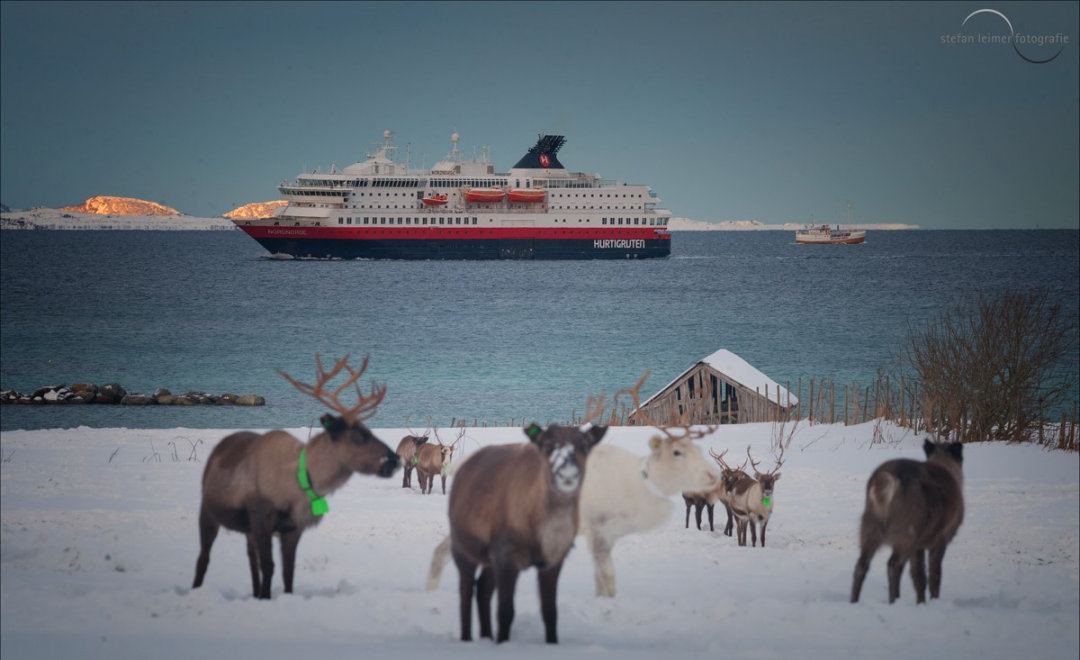
Well into the 20th century, sperm whales were still coveted prey for whalers because of their spermaceti and oil. Even today, the animals are a coveted trophy, but in a different way. Photographers and nature lovers would love to catch a glimpse of the mighty toothed whales that are the subject of so many legends. One of the best places to do this is near the northern Norwegian island of Andøya. And this is where guest author and journalist Stefan Leimer finds himself, who now works as a guide for Whalesafari, bringing guests closer to these and other marine mammals. After the winter (and the pandemic measures) the season could now be opened again.
On Wednesday, 2.2.2022 it was finally time again. 14 hardened tourists from Holland, Austria, Switzerland and Spain were warmly wrapped aboard the M/S Reine as we left the port of Andenes late in the morning in sunny winter weather and crisp -4°. The destination was Bleik Canyon. Here, ten nautical miles off the coast of Andøya, the continental plate breaks steeply down into the Arctic Ocean, forming a deep-sea trench up to 3,000 m deep. Nowhere in Europe is the distance from the coast to the edge of the continental shelf shorter than here.

In this underwater canyon, food is abundant and thus ideal conditions for sperm whales, which hunt their favorite food squid in the waters off Andenes. Such a colossus eats up to a ton of food every day. Their rhythm of life consists of diving, hunting, surfacing, resting, and diving back down to hunt. Approximately 90% of the lifetime is spent underwater by these toothed whales, which can dive to depths of over 2,000 meters and for more than 2 hours. In order to recover after such an energy-sapping hunt, they remain still on the water surface after surfacing and breathe noisily in and out every 15 seconds. This is the moment when we can watch them respectfully from our boat, the M/S Reine.

The construction of the M/S Reine began before the Second World War but was not completed until 1949. The M/S Reine, originally built for seal hunting, was sold to the “Vester Steamship Company” and used as a ferry ship in Lofoten and Vesterålen.

Later she was still converted into a fishing boat, but when the shipping company Maan Sjøfart A/S acquired the ship in 1991, the ship was marked by decay and had to be renovated at great expense. In 1992, the was then used for the first time as a whale-watching boat. In recent years, the ship has been renewed step by step and optimized for whale watching. Last but not least, two hydrophones were installed in 2001, allowing us to locate the sperm whales based on their clicking sounds. Sperm whales use these clicking sounds for navigation, to capture their food, but also for communication. Thanks to the underwater microphones we can locate the whales, so that when they appear, we are already near them and do not disturb them unnecessarily by fast travel.

After a 2-month break, we didn’t really know what to expect. The sperm whales – only males, by the way; the females live further south with their calves – do stay in the region all year round. But it can happen that we have to sail relatively far out to sea before we find them. Accordingly, the joy was great when we could soon receive the first clicking sounds of the sperm whales. To our great surprise, there were not only one or two sperm whales around. The clicking sounds in the headphones overlapped and we may assume that there were a good dozen whales within a radius of only a few kilometers. Several blows were visible on the horizon. No sooner had the first one dived off our bow than we could turn our attention to the next one. After we had observed and photographed 5 whales extensively, Captain Geir Maan decided to start the journey home to Andenes, where we arrived again at 14h00. With this wonderful day Whalesafari Andenes has successfully started its 33 season.
Link to the website of Whalesafari Andenes
More on the subject:






